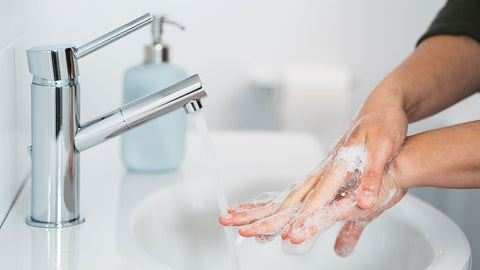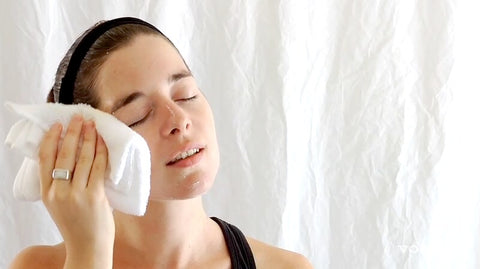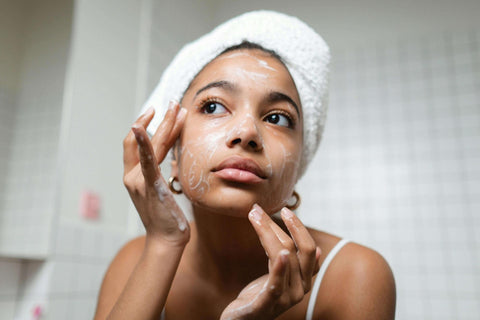How To Apply Homemade Natural Face Wash With Expertise

These days, the rise of homemade natural face wash has made it to the spotlight as people tend to care more about the sustainable effects and natural beauty routines. Yet, things that go viral are not always suitable for every individual, especially when they are related to beauty in general and skincare in particular.
Scroll down this Japan With Love article to unfold deeper insights into natural face cleansers to have the right approach to this trend and take good care of your skin.
1. 3 surprising benefits of using a natural DIY face cleanser
First and foremost, we need to understand what a natural Japanese face wash can bring to us rather than being led by the media's hypes. This section focuses on three main benefits that can articulate why people give this skincare niche enormous preferences.
1.1. Tailored to your skin type
Some people might argue that every other face wash type categorizes products based on skin type. However, each category still offers the range of many people instead of customizing the ingredients and formulas for your unique concerns. That's where the homemade natural face wash shines.
Living up to the name, DIY face cleansers follow recipes tailored to your skin type and preferences. Thus, you can rest assured that there will be no chemicals or ingredients that might cause irritation or allergies to your skin.
Check out The 5 Best Japanese Foam Face Washes for Healthy and Happy Skin here to diversify your choices of skincare products.
1.2. Gentler and safer for your skin

The DIY part satisfies your need for customization, while the natural ingredients offer you a gentler and safer face wash. Homemade facial cleansers exclude all harsh chemicals, such as parabens, sulfate, triclosan, talc, and fragrance, that might have extreme effects on your skin, especially sensitive ones.
Moreover, they can save your skin from being weakened and damaged due to the prolonged use of strong chemicals in industrial face washes. This type of face wash mostly uses ingredients from natural sources, such as herbs, to soothe your skin and gently remove all the dirt without stripping away essential sebum.
1.3. Friendly with the environment
Using organic and natural face washes can help significantly reduce the amount of plastic packaging and the consumption of toxic materials, such as paraben and sulfate. Thus, it can generate positive effects on our environment.
2. How to apply a natural DIY facial cleanser
Although the application process is not different, there are some aspects and related tips you should know to make the best out of this natural approach to your skincare. Here is the walkthrough of how you should apply a homemade face wash.
2.1. Before application

The first step is to clean your hands to remove potential bacteria that can cause unexpected effects or allergies. The additional tip is to dampen your face with lukewarm water before applying face wash as it can soften dirt and impurities; hence, dirt removal becomes much easier.
2.2. Application

The next step is to apply a dime-sized amount of face wash onto your fingertips. Such an amount is enough to have positive effects on your face, as using too much can strip your skin of essential natural oils.
When massaging your face with the cleanser, you should do circular motions and focus on areas prone to oiliness, such as the forehead, nose, and chin. Be careful with your dedicated eye as the skin there is thinner and more prone to irritation.
After around 30 seconds, you should rinse your face thoroughly with lukewarm water to remove all traces of the cleanser. Remember not to use too hot water for face rinsing as it can dry out your skin.
Check out Dove Botanical Selection Foaming Cleanser (Natural Radiance) 145ml - Japanese Foaming Cleanser to diversify your skincare choices.
2.3. After application

Related Product: Hatomugi W Cleansing Foam 130g
This step is not less crucial than the application step, which not many people recognize. Don't roughly rub your face, but gently pat your face dry with a clean, soft towel. You should also take notice of your towel's materials, whether they cause any irritation or allergy to your skin.
As the face is dry, you should apply a suitable moisturizer to your skin type to replenish hydration. It will help maintain a healthy skin barrier that can slow down the aging process.
3. How to make a DIY natural face wash
If you want to have a more active role in your skincare, the guide on how to make natural face wash below will form a solid foundation.
3.1. Step 1 - Choose ingredients
The insights into your skin type, whether it is dry, oil, sensitive, or combination, are vital to determine which ingredients should be in your DIY facial cleanser. For example, clay (bentonite and kaolin) and green tea are recommended for oily skin, while the oil of jojoba, avocado, and shea butter are the top choices for dry skin. Along these lines, doing deep research and consulting experts should be your priority in the process.
3.2. Step 2 - Find a recipe
There is wide-ranging information on a natural face cleanser DIY recipe for your reference and preferences. We will share here three popular regimens with simple processes and easy-to-find ingredients.

- Honey oat delight: 1 tablespoon each of raw honey, finely ground oatmeal, and lukewarm water for a gentle and exfoliating cleanse.
- Claytastic cleanse: 1 tablespoon of your chosen clay with 2 tablespoons of water or aloe vera gel for a deep cleansing experience suitable for oily skin.
- Hydrating haven: 1 tablespoon of plain yogurt with 1 tablespoon of honey and a teaspoon of olive oil for a nourishing cleanse for dry skin.
3.3. Step 3 - Mix and test
After choosing the suitable recipe for making your own face wash, it's time to mix the ingredients with the suggested amount in the recipe. After the mixture is ready, you should not apply it to your face immediately, but test it on a small area of your inner arm for 24 hours to check for allergic reactions.
If everything goes well, you can start using your DIY facial cleanser. If not, you need to change the recipe or ask for expert consultancy.
Disclaimer: The information here is for educational purposes only and should not be perceived as medical advice. The best option is to consult a dermatologist before starting any new skincare regimen, especially if you have any underlying skin conditions.
Cop this now:🌟 Cow Brand Soap Natural Comfortable Sake Lees Face Wash Soap 80g - Facial Cleansing Soap Bar
4. FAQs
4.1. Is using a natural DIY face wash effective?

Yes, it is. The facial cleanser can satisfy your purpose of cleansing the skin with a gentler approach by using natural ingredients instead of harsh chemicals. However, the effectiveness is only obvious if everything matches your skin type, such as the recipe you choose, the way you apply, and how you store the cleanser.
Besides doing DIY face washes, you can still use tested Japanese face wash products, as they also use natural ingredients for gentler cleansing without removing all crucial oils from your skin.
4.2. How should I store a DIY natural face cleanser?
You can mix all the ingredients following the recipe and store the mixture in an airtight container in a dry, cool place. The best tip is to make smaller batches for fresher use and better storage due to the lack of preservatives. Another way is to store your fresh materials and mix them right before your face wash.
4.3. What are the best natural face cleansers?
Some recommended face washes that go straight to the top are Hatomugi cleanser and SK II cleanser. There are many great recommendations on the market for budget-friendly prices. The best tip is to look at their ingredients which mostly come from herbs or botanical sources and should not include harsh chemicals such as sulfate, alcohol, and paraben.
5. Conclusion
We hope the comprehensive walkthrough of homemade natural face wash has provided you with helpful insights and practical recommendations on recipes, application guides, and additional tips. Follow Japan With Love to explore more updated information on beauty tips and amazing skincare products.

Leave a comment